Nearly nine decades after the first Reliant was hand-built, this most idiosyncratic of British car manufacturers still has an army of loyal fans
Words: Paul Guinness
In its heyday Reliant was the world’s largest producer of three-wheeled vehicles, with more than 10,000 trikes a year rolling out of its Tamworth factory gates. It was all a far cry from the firm’s humble beginnings, when company founder T L Williams produced a three-wheeled van featuring a motorcycle front end, a 750cc V-twin engine and a hardwood body frame clad with aluminium panels. With Raleigh about to cease production of a similar vehicle, Williams was convinced there was still a market for such a creation.
Indeed there was. With the new design licensed, Williams began production of his three-wheeled van in the summer of 1935 at a disused bus depot in Watling Street, Fazeley. The newcomer was named the Reliant and was powered by a 600cc JAP engine, replaced by a 747cc Austin Seven engine by 1938.
The early post-war years saw Reliant recommencing its van production, launching the new Regent in 1946 – still featuring a motorcycle-type front end but now with a gross vehicle weight of 10-12cwt depending on which version was chosen. But it was with the arrival of car production that Reliant’s rise to glory finally began.
This major turning point occurred in 1952, when Reliant put its first passenger car – the Regal – into production. Still featuring a wooden frame and aluminium panels, the Regal went through six different generations during its first decade on sale, and was available in a choice of saloon, convertible and commercial guises. Under the bonnet was the familiar ex-Austin sidevalve engine, giving the Regal reasonable performance for the time. Suddenly, Reliant was becoming a major player in the economy car market of ’50s, providing buyers with a cost-effective solution to their motoring needs.

With up-to-date styling and a sophisticated engine, the Regal 3/25 proved popular when it arrived in 1962.
It was, however, with the announcement of the crucial new Regal 3/25 in 1962 that Reliant took the biggest step of all. Not only was the newcomer bang on trend (with miniature tail fins and an Anglia 105E-type reverse-rake back window), it featured Reliant’s brand new all-alloy overhead-valve engine – the first unit of its kind in Britain. This eager new powerplant was available initially in 598cc guise, later upgraded to 700cc for the Regal 3/30. Just as crucially, however, the latest Regal featured a steel chassis with all-glassfibre bodywork, a first for Reliant and a specification it would adopt for all future models.
The new-look Regal range proved to be a major hit, smashing all previous sales records for the company and remaining in production for an impressive eleven years. The van version – known as the Supervan – was particularly popular, and still is now. Aided by its long-term starring role in the BBC hit series ‘Only Fools and Horses’, the Supervan became a global icon – and one of the most instantly recognisable vehicles on the planet.
It was with the Regal’s successor – the 1973–1981 Robin – that Reliant moved up a gear, bringing the three-wheeler concept into a bright new era. Even its styling was bang up to date, thanks to the imagination of Tom Karen of Ogle Design fame. And things got off to a great start, with healthy sales throughout the early years. If you had £801 to spend, you could buy a brand new basic Robin back then – but an extra £48 bought you the Super Robin, with better trim, a bit more comfort and even the option of alloy rear wheels.
The original-shape Robin lasted eight years in all, finally replaced at the 1981 Motor Show by the restyled Rialto. The Robin name would reappear at the end of the 80s, however, on a modified version of the Rialto. And, of course, the very last of the Reliant three-wheelers were also called Robins, but with all-new styling and the kind of on-board ‘luxury’ (relatively speaking) that buyers of previous Reliant could only dream of.
But, of course, the world was moving on. The number of people willing to buy a brand new three-wheeler that could be driven on a motorcycle licence was dwindling. Reliant’s customer base had shrunk, and production numbers were in terminal decline. The company itself faced financial difficulties and changed hands a number of times during the 1990s. Beans Engineering acquired Reliant in 1992, but the company was in trouble once again four years later – prompting ex-Jaguar man Jonathan Heynes to step in. Heynes managed to cut costs, improve the design of the Robin and move the company’s production base to Cannock, but ultimately it was all in vain.
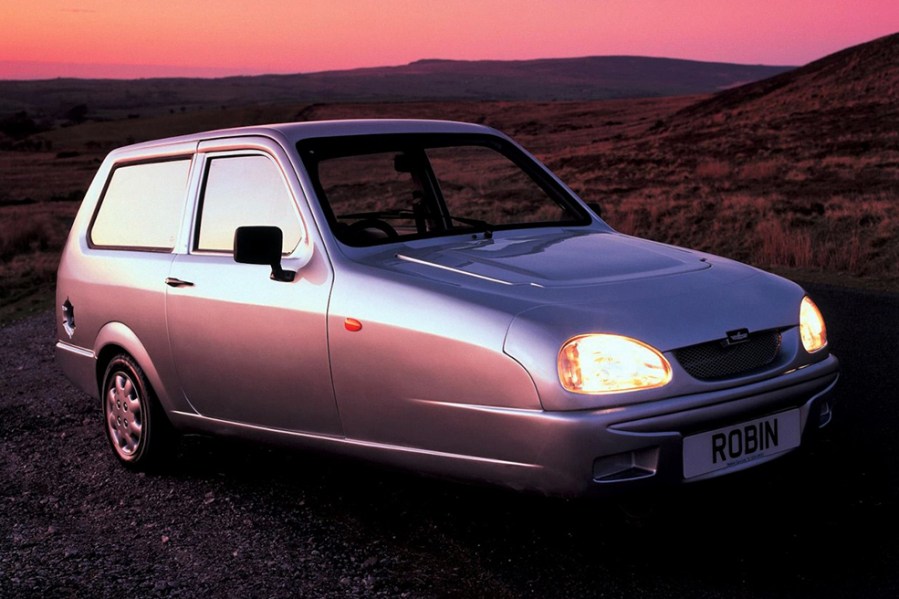
The Mk3 Reliant Robin added a modern front end (and Vauxhall Corsa headlights) to an aging design in 1999. Production finally ended in 2002.
It was announced that production of the Robin (now in Mk3 guise, and featuring a Heynes-designed rounded front with ‘teardrop’ headlamps) would cease in 2000, although in the end a flurry of final orders saw it continuing through to early the following year. That’s when Sudbury-based B&N Plastics entered the story, negotiating to buy the rights to the Robin and producing an updated version under license from Reliant by late 2001. Sadly though, even that project floundered in 2002 after only a tiny production run.
As something of a contrast to its economy car offerings, Reliant also enjoyed long-term success in the sports car market, initially with the 1961–1963 Sabre. The company’s efforts really started to pay off by 1964, however, when the handsome new Scimitar Coupe entered the scene, based on a 1962 Ogle-designed concept car. Using a modified Sabre chassis, the Scimitar coupe remained in production for six years and was Ford powered throughout that time, its initial straight-six being replaced by a 2.5-litre V6 by 1967. It succeeded in pushing Reliant into a whole new market sector from the company’s traditional offerings, although it was the next-generation Scimitar that would really hit the headlines.
What Reliant needed was something genuinely individual, a car with a unique selling point. The result? The Scimitar GTE, Britain’s first sporting car with semi-estate versatility. The new-for-1968 GTE sat on a larger chassis, with a longer wheelbase and wider track than before. And the glassfibre bodyshell was all-new too; its front end was influenced by the previous Scimitar’s look, albeit smoother and more up to date. But it was at the back where things got really interesting…
This wasn’t an estate car in the true sense; it doesn’t matter how hard you tried, there’s no way you’d squeeze your new G-plan sideboard into the back. But it was a far more capacious machine than we’d come to expect from any model with sporting credentials, with a decent-size glass tailgate lifting up to reveal generous boot space, plus the versatility of folding back seats for larger loads.
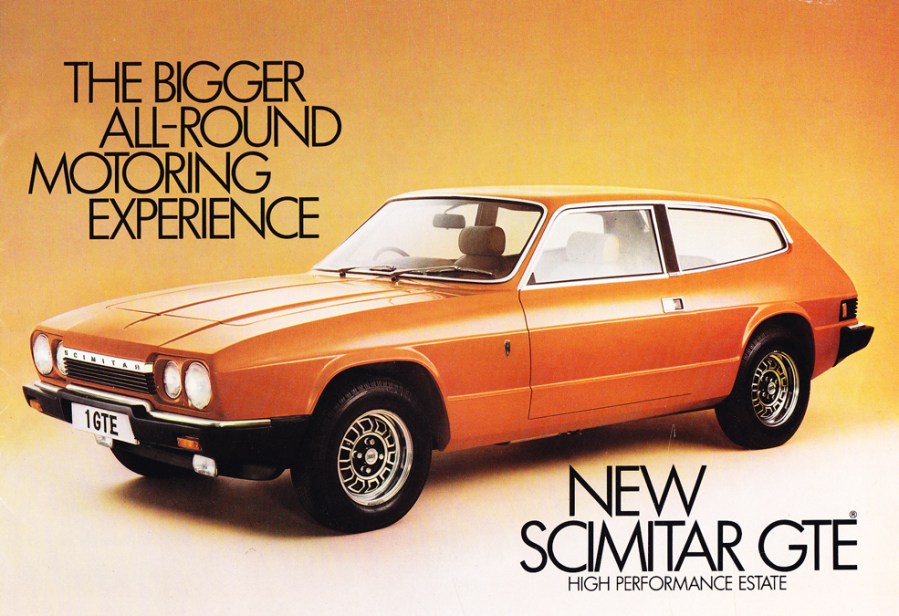
The Reliant Scimitar GTE combined sports car character with shooting-brake practicality. Today, it’s a a great alternative to the British classic sports car mainstream.
Power source for the GTE came from Ford’s Essex V6, endowing the car with strong performance and effortless cruising. Top speed was around the 120mph mark, and by 1971 punters could choose from either a manual-overdrive gearbox or fully automatic. Biggest change, however, came in 1976 with the launch of the Scimitar GTE SE6, a squared-off, longer, wider version of the GTE that was more in keeping with styling of the time, as well as offering even more space on board.
The last big GTE change occurred in 1982, when Ford’s 3.0-litre Essex was replaced by the 2.8-litre Cologne unit. A convertible Scimitar GTC also arrived, though just 400-plus of these were ever made, despite very positive press reports at the time of its launch – with many pundits referring to it as a ‘Stag for the 1980s’. But there was no mistaking the age of the Scimitar’s basic design, and by 1986 it was finally out of production, with various attempts at resurrecting the GTE ultimately ending in failure.
Reliant had other sporting ambitions during the 1980s, with company bosses spotting a gap in the market following the demise of popular roadsters like the MGB and TR7. The end result was the new Scimitar SS1 of 1984, the very last car styled by Italian design legend Michelotti to make it into production.
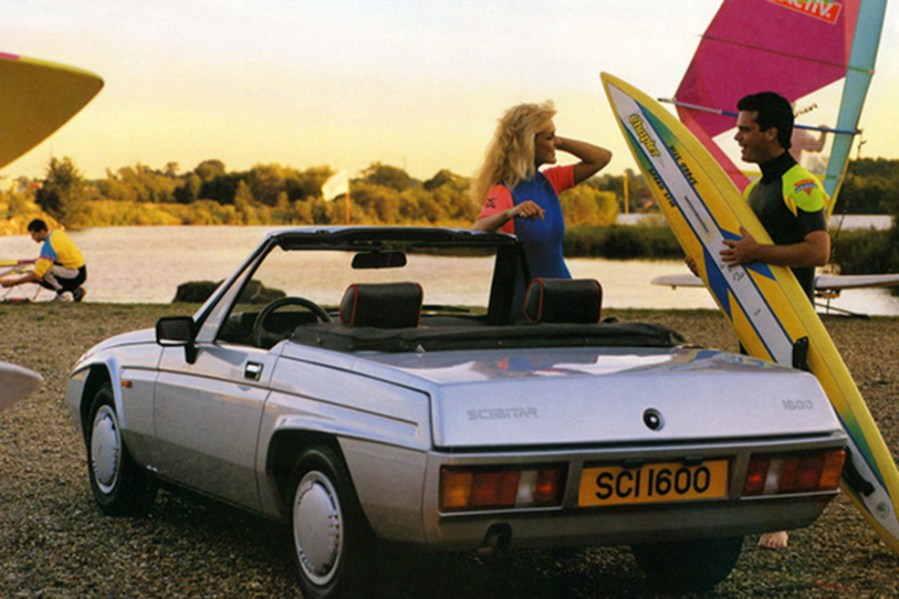
Like the Regal 3/25, the Scimitar SS1 boasted trendy styling and strong engines – but it couldn’t match its increasingly impressive rivals
The SS1’s basic wedge-shaped profile was pleasant enough, and typical of Michelotti’s thinking at the time; but the large panel gaps and awkward creases along the sides made it look crude, as did the flip-up headlamps. Perhaps not surprisingly, buyers weren’t particularly impressed, and sales of the SS1 remained low – despite the launch of the rapid new (Nissan-powered) 1.8 Turbo version in 1986.
The two-seater Scimitar ended up being restyled by British designer William Towns and re-launched in 1990 as the SST (‘T’ for ‘Towns’), together with smoother lines and a simpler approach; and two years later it found itself renamed again, this time badged as the Scimitar Sabre and available with 1.4-litre Rover K-series power if required. But it was all too late for the Scimitar to enjoy a sales surge, and by 1995 this much underrated sportster was being laid to rest.
Reliant enjoyed success with a number of overseas projects over the years, the first of which was its arrangement with Autocars of Israel. This led to a couple of fibreglass-bodied saloons known as the Carmel and Sussita, but the most interesting model was the Autocars Sabra, which came about when Autocars acquired the rights to Britain’s Ashley sports car and approached Reliant to help develop it further. The end result was the production-ready Sabra, featuring 1703cc Ford power and created primarily for the American market. Reliant ended up building the first hundred Sabras at its Tamworth factory, however, before production switched to Israel.
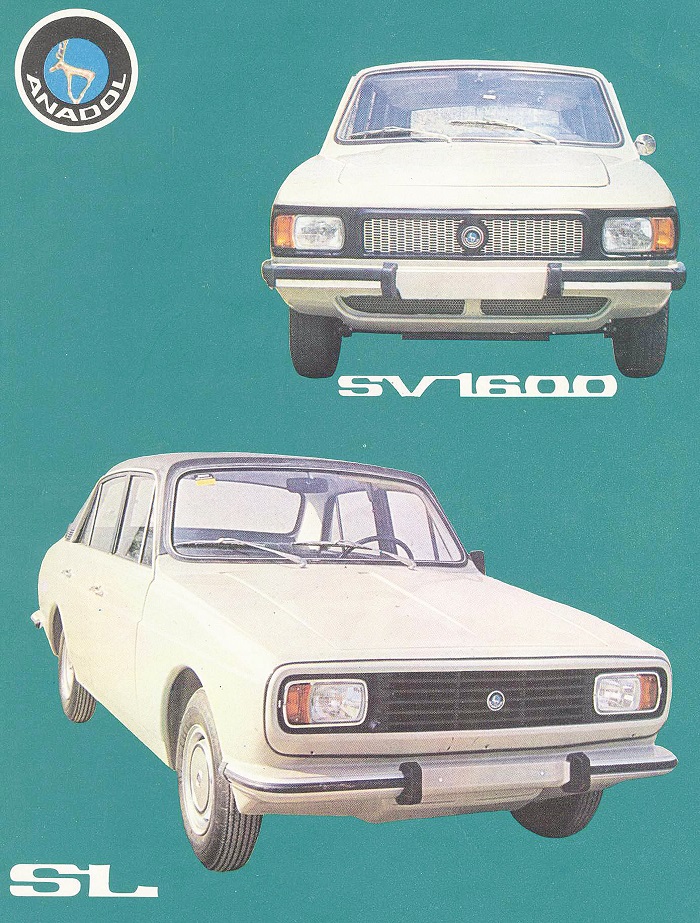
The Otosan Anadol was a joint effort between Reliant and Turkish firm Otosan Otomobil Sanayii. In its original form it was the country’s first mass-produced car.
In the end, Israeli production of the Sabra totalled fewer than 350 units; but its legacy lived on, with Reliant seeing potential for a British-spec version. The Sabra was duly modified, renamed Sabre and put into production – marking the beginning of a long and successful sporting career for the Tamworth firm.
Another fascinating link-up for Reliant was with Otosan Otomobil Sanayii of Istanbul, resulting in the Otosan Anadol of 1966, Turkey’s first mass-produced car. Developed by Reliant, with styling by Ogle Design, the glassfibre-bodied two-door Anadol went into production in 1966, followed by a four-door version four years later. The four-door lasted through to 1981, by which time it had sold more than 35,000 units.
Equally important to Reliant was its collaboration with Greek scooter manufacturer Mebea, with which it worked from 1970 through to the early 80s. First to be produced (from CKD kits sent over from Tamworth) was the TW9 three-wheeled ‘light lorry’, followed by a Mebea version of the Robin by the mid-1970s. But it was with the Mebea Fox – a four-wheeled utility vehicle – that the two companies had the biggest success.
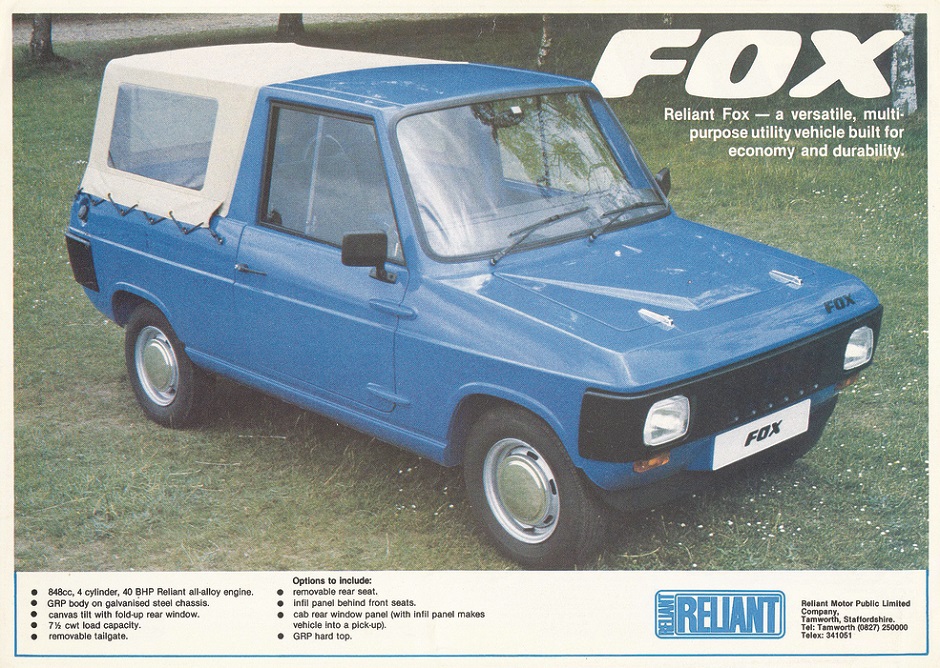
Originally intended for the Greek market, the Reliant Fox wasn’t a huge seller but hung around until the late 1980s
Launched in 1979, the Fox took advantage of Greece’s tax laws of the time, which were favourable towards utility vehicles. When this changed in 1983, however, and the Fox found itself taxed at the same rate as passenger cars, Reliant took the decision to launch a British-built version in the UK – complete with a canvas-covered pick-up rear and optional hardtop. It wasn’t a huge seller but it did at least keep the Fox concept alive through to the end of the 1980s.
Aside from the Fox, Reliant offered two other four-wheeled economy cars over the years, kicking off with the 1964-74 Rebel (of which just 2400 were made) and finishing with the 1975-82 Kitten, marginally more successful thanks to a production run of 4074 cars. The Kitten in particular was a likeable little thing, being essentially a four-wheeled Robin; but it was always at a price disadvantage to the evergreen Mini, a fact that would affect its sales potential.
Reliant showed even more innovation, of course, with its acquisition of arch rival Bond in 1969, which saw the latter’s Preston factory closed and the old 875 three-wheeler and Equipe sportster discontinued. In their place came the new Bond Bug, based around the chassis and running gear of the Regal but featuring dramatic wedge-shaped styling via the genius of Ogle Design’s Tom Karen. The Bug filled an interesting niche in the market, selling 2270 units during its four years on sale.
Reliant, you see, was a company not afraid to try new things. Even within its staple market – the three-wheeler sector – it showed innovation and creativity, from the earliest Regal saloons through to the big-selling Robin of the 1970s. Reliant’s ability to tackle different market segments via a diverse line-up was unrivalled at the time, and yet somehow it worked.
From an economy-conscious Yorkshire miner investing his savings in a trike through to Princess Anne’s unstinting loyalty to the Scimitar family over the years, Reliant managed to cross the class barriers and bring real individuality to the market throughout its turbulent existence. Quite simply, Reliant was unique – and there are many enthusiasts who still mourn its demise.





